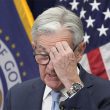by Hubert Marleau, Market Economist, Palos Management
Palos’ Last Weekly Macro Commentary of the Year Submitted December 16, 2022
Questions about inflation and growth were the two economic forces that dominated the market in 2022. They had a “grand finale” this week. If there was a week that would be able to shake the Fed and move the bar for investors, it would have been this one. Inflation didn’t look as stubborn as many insisted and growth had a hard time holding on. In fact, the transition to lower inflation and moderate growth was a lot smoother than many antagonists thought possible. It explains why the S&P 500 has wavered for the past few weeks around the 4000 flat line. For no known rational reason, Powell threw a wrench at inflation and seized the wheel of activity by spiking its spokes.
The market was not enamoured with the signal that the Fed was not going to back off. Powell said that it was planning more hikes than most market makers think necessary to combat inflation. Strangely, the language of the monetary authorities was unchanged from November, even though there was ample evidence that inflation had receded and growth softened. Retail sales and industrial production slumped disappointingly in November. The S&P Flash Composite Output, which gauges economic activity in the manufacturing and service sectors, contracted in December to 44.6, a four-month low and for the sixth consecutive month. Incidentally, Larry Summers, an imperious critic of the Fed, declared on “Wall Street Week” before Powell delivered his assessment: “I think we are in better shape than I thought we were. The inflation numbers are good, and policy is in the right place.”
Investors did not like the idea of tightening into a series of economic setbacks. Moreover this lack of sympathy on the part of the Fed was made worse for the market as it faced the expiration of $4.0 trillion worth of options - the largest in four years - in an event called a “quadruple witching hour”, which usually boosts volatility.The S&P 500 lost 83 points in the last 5 days, registering a 2.1% decline. At the close on Friday it stood at 3852.
I was baffled by the tone of the official statements because it is hard to square with the new data. It’s almost impossible to figure it out. Perhaps it's posturing on the part of Powell, who wants the market to believe that the Fed has unfinished business. The WSJ in an editorial wrote that he wore his finest hawk feathers and that he doesn’t want to be defined as an impostor behind a Paul Volker mask.
Inflation Does Not Look That Sticky
On Tuesday, the Bureau of Labour Statistics reported that consumer prices had risen 0.1% last month from October - well short of the 0.3% economists expected, putting overall prices 7.1% above their year-earlier level, the 5th consecutive month of year-over-year slowdown. Andrew Lees of MacroStrategy Partnership made the astute observation that the 5-month annualised rate was down at 2.4%, basically within target range. And it keeps on going. Import price fell 0.6% m/m in November, their 5th consecutive monthly decline, giving an annualised fall over that period of 10.5% compared with an annualised increase of 16.9% in the first 6 months of the year. Incidentally, U.S. terms of trade are still improving - a camouflage inflow of capital that is bullish for the dollar - because export prices continue to outperform import prices. To top it off, the NY Fed’s Underlying Inflation Gauge (UIG), which captures sustainable movements in inflation from information contained in a broad set of price, real activity, and financial data, is currently estimated at 4.1%, a 0.2% decrease from October.
The notion that inflation has peaked is now nearly universal among fund managers. A net 90% of them believe that inflation will be lower than it is now in 12 months, says Bank of America. In this connection, it is not surprising that the swap market is forecasting that in one year's time, the inflation will be running at 1.92% - right on the Fed's target.
Growth Falling but Initial Jobless Claims Are Stubbornly Holding On
The Atlanta Fed’s NowCasting Model is predicting that the economy will grow at an annualised rate of 2.8% in Q4, even though all the indicators that the National Bureau of Economic Research (NBER) monitor have peaked. What is intriguing is the reluctance of businesses to let blue collar workers go. In fact, recent layoffs and hiring freezes have mostly hit the technology sector and white collar jobs. Indeed, many companies are hiring workers that have lost their jobs in the technology sector, as they are looking for ways to digitise their businesses, hoping to squeeze operating costs, raise processing efficiencies, and cut administrative expenses. This new business initiative of preserving workers to avoid the cost of retraining employees is the main reason why the forthcoming contraction will likely be relatively mild.
The Cycle of Interest Hikes Will End Very Soon.
On Wednesday, the Fed moved the federal funds rate to a new range of 4.25%-4.5%, which is likely high enough to finish the inflation job. Deliberations over how high interest rates need to be were probably acute, policymakers projecting rates would end next year at 5.00%. Recent economic prints, however, have only put a few Fed officials in a better mood. That is why, as a whole, they will still vote in favour of raising rates one last time by 25 bps on February 1, to make sure that inflation is dragged down to its long-standing 2% target.
Everything is in place; the money supply has fallen, the yield is inverted and the policy rate is above neutral. There is now no God-given reason to have a terminal rate any higher than 4.75%.The demand destruction approach, which has been the focus of the monetary authorities to date, is no longer what’s needed to arrest inflation. Maybe Powell does not know that, but the Fed surely does. He treats the economy like a lawyer, insisting on only truism and refusing to acknowledge the research products of his own economists. The Philadelphia Fed confirmed last week that U.S. payrolls have been overstated by at least 1.1 million between March and June, stating its estimates incorporated more comprehensive and accurate estimates released by the Bureau of Labor Statistics. As of November, this overstated divergence has possibly grown to 2.7 million. THAT IS ABOUT 2.0% OF THE WORKFORCE. Knowing this, would you still have raised interest rates?
Despite all the apparent hawkish pronouncements made by Powell, he did say during his most recent press conference that the Fed only needs to be convinced that inflation is moving down in a sustainable way. In other words, it would pause all rate hikes if future m/m increases in the CPI were to be somewhere around 0.17% for a few more months (I say two months). This is bound to happen. Thus the finish line is close. What we just had was a “Fed Fake”.
The Return of the Old Normal
The market has not made peace with the Fed’s “higher for longer” narrative to get back to some normalcy. Yet, a growing crowd of investors is betting that the Fed will put it off. There is a lot of money pouring into stocks that stand to benefit from cooling inflation like staples, REITs, utilities and growth maintenance such as industrial, materials and energy. I trust that the monetary authorities will come to their senses, when they see that they have raised the policy rate high enough to where it ought to be to return the economy to a 2-plus-2 configuration - that is 2% for inflation and 2% for growth.
Edward Yardeni, Chief Investment Strategist at Yardeni Research, argued in a note to his clients that the exorbitant valuations had passed in a relatively tranquil manner for average investors. “Most of the bubbles have already burst, so not much collateral damage lies ahead.” Indeed, there has been plenty of bad news this year such as the bursting of the bubble in the bond market, the cryptocurrency calamity, and the SPAC debacle.
In this regard, should the economy produce S&P 500 earnings per share of about $275 in 2024 compared to the current 12-month forward earnings of $249, it would provide a decent story for resumption of growth in the out year and justify lower discount rates. The current situation may turn out to be a good moment to start loading up slowly with stocks that have decent valuations, enviable growth prospects, and/or attractive dividend yields. Think on this one, the insiders are buying, while the sentiment on the street is panicky.
Source: Barron’s Market Lab.
Copyright © Palos Management















